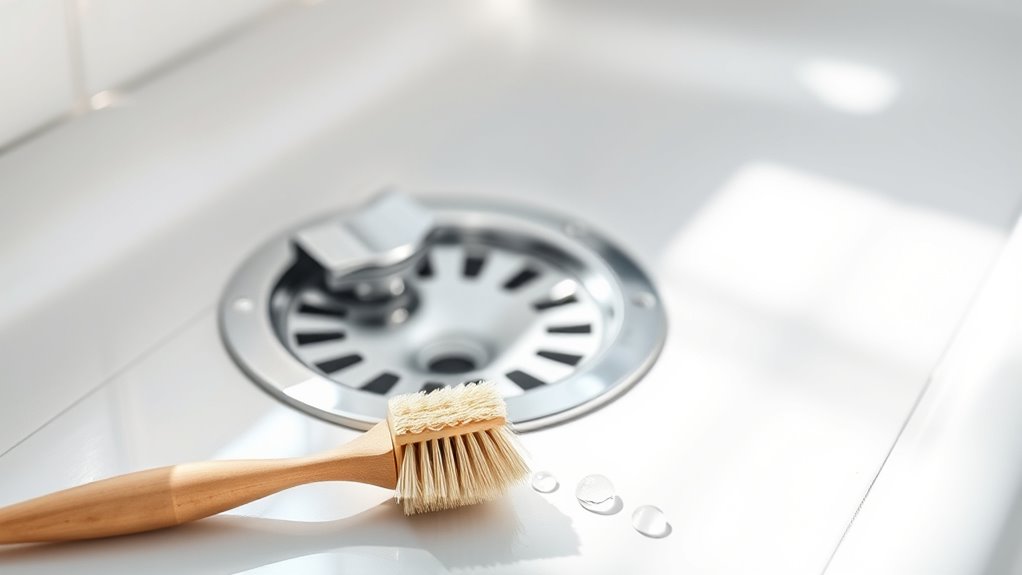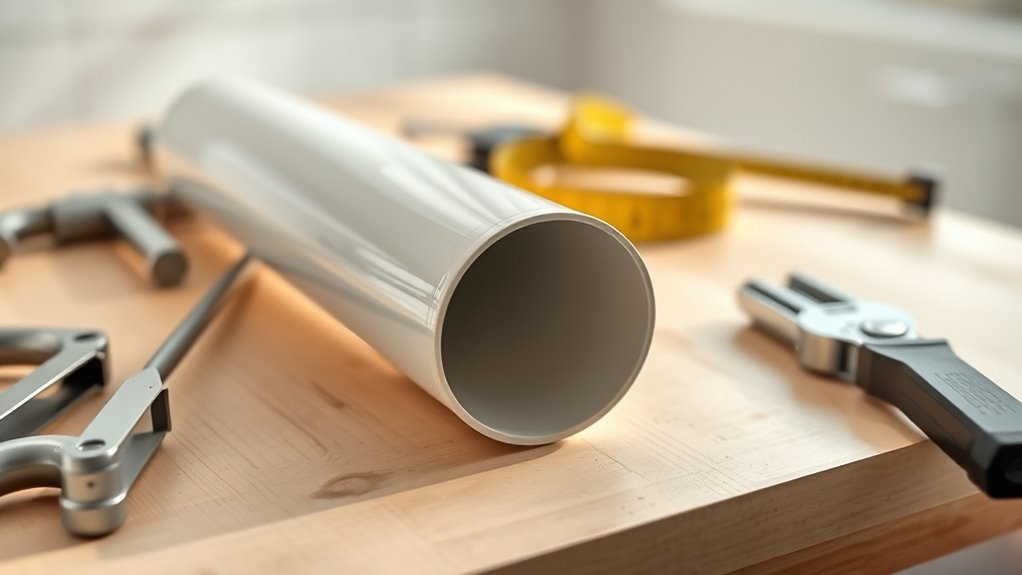To install a bathtub drain pipe, start by gathering necessary tools and materials. Next, turn off the water supply. Remove the existing drain assembly and clean the drain opening thoroughly. Measure and cut the new drain pipe to the correct length. Reinstall the bathtub and connect the overflow assembly. Finally, finalize all plumbing connections and restore the water supply. Testing drainage and checking for leaks is essential. Additional details on each step can enhance this process.
Gather Necessary Tools and Materials

Before beginning the installation of a bathtub drain pipe, it is vital to gather the necessary tools and materials.
A pipe wrench is important for securing the drain pipe, while a pair of pliers will assist in tightening fittings. A hacksaw may be needed for cutting pipes to the correct length, and plumber’s tape helps to guarantee leak-free connections.
Additionally, a measuring tape is important for accurate measurements, and a level guarantees proper alignment. Collecting a bucket will catch any excess water during the installation process.
Finally, having safety gear, such as gloves and goggles, is advisable to protect against debris and sharp edges. With these tools and materials at hand, the installation process can proceed smoothly.
Turn Off Water Supply
Turning off the water supply is an essential step before installing a bathtub drain pipe. This action prevents water from flowing during the installation process, ensuring a dry and safe working environment.
To effectively turn off the water supply, one should follow these steps:
- Locate the Main Shut-off Valve: This valve is usually found near the water meter or where the main water line enters the home.
- Turn Off the Valve: Rotate the valve clockwise until it stops, ensuring that no water will flow through the pipes.
- Open Faucets: Open the bathtub faucet and any other faucets in the house to relieve pressure and drain any remaining water in the pipes.
Remove Existing Drain Assembly
To successfully remove the existing drain assembly, specific tools are necessary to guarantee a smooth process.
This section outlines the required tools and provides a clear step-by-step removal procedure.
Understanding these details will facilitate the replacement of the drain assembly effectively.
Tools Required for Removal
Removing the existing drain assembly requires a specific set of tools to guarantee a smooth and efficient process.
To effectively complete this task, the following tools are essential:
- Plumber’s Wrench: This tool is vital for loosening and tightening the fittings securely attached to the drain assembly.
- Screwdriver Set: A variety of screwdrivers, including flathead and Phillips, will help remove screws holding the drain in place.
- Pliers: Needle-nose or channel-lock pliers are useful for gripping and turning small components or nuts that may be difficult to reach.
Having these tools on hand will facilitate a quicker and more organized removal of the existing drain assembly, setting the stage for successful installation of the new drain pipe.
Step-by-Step Removal Process
A systematic approach is essential when removing the existing drain assembly to guarantee the process is efficient and effective.
First, verify the bathtub is free of water and any obstructions. Using a screwdriver, detach the drain cover by removing screws, if applicable.
Next, apply a drain wrench to grasp the drain body and turn it counterclockwise to loosen and remove it from the tub. If the drain is stubborn, a penetrating oil can aid in loosening.
Once removed, inspect the area for any remaining debris or old sealant. Clean the surface thoroughly to prepare for the new drain assembly.
Finally, verify all tools are put away and the work area is left tidy, ready for the next installation phase.
Clean the Drain Opening

Cleaning the drain opening is an essential step in guaranteeing proper water flow and preventing clogs. A clean drain enhances the overall efficiency of the bathtub drainage system.
The following steps should be taken to guarantee a thorough cleaning:
- Remove Debris: Start by using a flashlight to inspect the drain for hair, soap scum, or other debris. Utilize a pair of pliers or a drain snake to remove any visible obstructions.
- Clean with Vinegar and Baking Soda: Pour a mixture of vinegar and baking soda into the drain. This natural cleaner helps break down grease and grime.
- Rinse with Hot Water: Finally, flush the drain with hot water to clear away any remaining residue and guarantee smooth water flow.
Following these steps will help maintain a clear and functional drain.
Measure the Drain Pipe Length
To accurately install a bathtub drain pipe, precise measurement of the drain pipe length is essential.
Various tools are required for this task, and understanding standard drain pipe sizes will aid in selecting the correct length.
Additionally, employing effective measuring techniques guarantees a proper fit and ideal functionality of the drain system.
Tools Needed for Measurement
Proper measurement of the drain pipe length is vital for a successful bathtub installation. Accurate measurements guarantee that the drain pipe fits perfectly, preventing leaks and future issues.
To achieve this, several tools are necessary for precise measurement.
- Measuring Tape: A flexible measuring tape allows for easy measurement of both straight and curved surfaces, guaranteeing the correct length is obtained.
- Pipe Cutter: This tool is used to cut the pipe to the exact length needed, providing a clean edge for installation.
- Level: A level guarantees that the drain pipe is properly aligned, which is essential for effective drainage.
Using these tools will aid in achieving an effective installation, contributing to the overall success of the project.
Standard Drain Pipe Sizes
Standard drain pipe sizes are essential for ensuring a proper fit during bathtub installations. The most common sizes include 1.5-inch, 2-inch, and 3-inch diameters. Each size caters to different drainage needs, impacting flow rates and suitability for various bathtub models. Understanding these dimensions helps in selecting the right pipe for efficient drainage and preventing clogs.
| Pipe Diameter | Common Use | Typical Length |
|---|---|---|
| 1.5 inches | Standard bathtubs | 4-5 feet |
| 2 inches | Larger bathtubs | 5-6 feet |
| 3 inches | Commercial use | 6-8 feet |
Choosing the correct standard size can streamline the installation process and enhance overall functionality.
Measuring Techniques Explained
Accurate measurement of the drain pipe length is fundamental for a successful bathtub installation. Properly sizing the drain pipe guarantees ideal drainage and prevents future plumbing issues.
The following measuring techniques are essential:
- Determine the Drain Location: Identify the exact position of the bathtub drain in relation to the existing plumbing system. This helps in calculating the necessary pipe length accurately.
- Measure the Vertical and Horizontal Distances: Use a tape measure to find both the vertical and horizontal distances from the bathtub’s drain to the main drain line. This information is crucial for precise pipe cutting.
- Account for Fittings and Angles: Consider any bends or fittings that may alter the effective length of the pipe. Adjust the measurements accordingly to guarantee a proper fit.
Cut the New Drain Pipe

Once the measurements for the new drain pipe have been determined, cutting the pipe to the appropriate length becomes the next important step.
The installer should use a pipe cutter or a hacksaw to guarantee a clean, straight cut. It is essential to mark the cutting line clearly, using a permanent marker or a pencil, to avoid any errors.
Before cutting, the installer must double-check the measurements to confirm accuracy. After cutting, the ends of the pipe should be smoothed with a file or sandpaper to remove any burrs that could impede proper sealing later.
Proper preparation at this stage is critical for a successful installation, as it directly affects the integrity and function of the bathtub drain system.
Install the Drain Flange
To install the drain flange, the installer begins by applying a bead of plumber’s putty around the underside of the flange. This seals the connection and prevents leaks.
Next, the installer positions the flange into the drain opening, making certain it sits flush against the bathtub surface.
Once in place, securing the flange requires several steps:
- Align the screw holes with the pre-drilled holes in the tub.
- Insert the screws and tighten them evenly to avoid warping the flange.
- Wipe away any excess putty that may have oozed out during installation.
Following these steps guarantees a secure, watertight fit for the drain flange, setting the stage for the next stages of the bathtub drain installation.
Apply Plumber’s Putty
With the drain flange securely installed, the next step involves applying plumber’s putty to guarantee a watertight seal. This step is essential to prevent leaks that could lead to water damage. A small amount of plumber’s putty should be rolled into a rope-like shape and placed around the underside of the drain flange. It is important to evenly distribute the putty to guarantee complete coverage. Once applied, the flange can be pressed into the drain opening, allowing the putty to spread and form a tight seal.
| Material | Purpose | Application |
|---|---|---|
| Plumber’s Putty | Seal leaks | Apply around drain flange |
| Drain Flange | Connect drain pipe | Secure to bathtub |
| Drain Opening | Allow drainage | Fit flange snugly |
Connect the Drain Pipe to the Trap
Connecting the drain pipe to the trap is an important step in guaranteeing proper drainage for the bathtub. This connection allows wastewater to flow efficiently while preventing sewer gases from entering the home.
To achieve this, follow these steps:
- Align the Drain Pipe: Position the drain pipe so that it fits snugly into the trap. Confirm there are no obstructions that might impede the connection.
- Insert the Pipe: Gently push the drain pipe into the trap, making sure that it reaches the designated depth for a secure fit.
- Check for Level: Use a level tool to confirm that the drain pipe is aligned correctly with the trap, which helps maintain consistent drainage and reduces potential leaks.
Completing this step accurately is vital for a successful installation.
Secure the Connections
Securing the connections between the drain pipe and the trap is essential for preventing leaks and guaranteeing a reliable plumbing system.
To achieve this, the installer should use appropriate fittings and guarantee that all connections are tightened adequately. This typically involves using a wrench to secure slip nuts, ensuring they are snug but not overtightened, which could risk damaging the pipes.
Additionally, applying plumber’s tape to threaded connections can provide an extra layer of protection against leaks. Care should be taken to align the pipes properly before securing, as misalignment can lead to stress on the connections.
Once everything is securely fastened, the installer can proceed with further steps to enhance the overall integrity of the system.
Test for Leaks
After confirming all connections are fastened properly, the next step involves checking for leaks. This vital process helps to prevent potential water damage and guarantees the installation is successful.
To effectively test for leaks, one should follow these steps:
- Visual Inspection: Examine all joints and connections for any signs of moisture or water pooling.
- Water Test: Fill the bathtub with water, allowing it to sit for several minutes. Observe the drain area for any dripping or leaking.
- Tissue Check: Place a dry cloth or tissue around connections and joints. After a few minutes, inspect it for any signs of wetness, indicating a leak.
Reinstall the Bathtub
Reinstalling the bathtub requires careful attention to detail to guarantee a secure fit and proper alignment with the plumbing.
First, the installer should lift the bathtub into position, ensuring that the drain aligns with the newly installed drain pipe. It is essential to check that the bathtub sits level, as an uneven surface can lead to drainage issues.
Once properly aligned, the installer can secure the bathtub to the wall studs using brackets or screws, reinforcing stability.
After securing, a bead of silicone caulk should be applied around the edges to prevent water seepage.
Finally, the installer should double-check all connections before proceeding to the next steps, ensuring a seamless reinstallation process.
Connect the Overflow Assembly
Connecting the overflow assembly is an essential step in ensuring proper drainage in a bathtub.
This process involves understanding the various components of the overflow assembly and employing effective installation techniques. Attention to detail here can prevent leaks and enhance the overall functionality of the bathtub.
Overflow Assembly Components
The overflow assembly is an essential component in a bathtub’s drainage system, ensuring that excess water is efficiently diverted away from the tub.
This assembly typically consists of several key components that work together to prevent overflowing.
- Overflow Plate: This visible part, usually located on the tub’s side, provides access to the drain while allowing water to flow through when the water level rises.
- Overflow Tube: A pipe that connects the overflow plate to the drain, channeling excess water directly into the drainage system.
- Drain Stopper: A mechanism that controls the tub’s water flow, allowing users to fill the tub or drain it as needed.
Together, these components contribute to the effective functioning of the bathtub’s overflow system.
Proper Installation Techniques
Establishing a secure connection for the overflow assembly is vital to guarantee the bathtub functions properly and prevents leaks.
To begin, the installer must align the overflow pipe with the tub’s overflow opening. A rubber gasket should be placed between the pipe and the tub to provide a watertight seal.
The next step involves securing the overflow plate to the tub using screws, making sure it fits snugly against the surface. It is essential to avoid overtightening, as this can cause damage.
Afterward, the installer should connect the overflow pipe to the drainage system, ensuring it is properly aligned and secure.
Finally, a test for leaks can be conducted by running water in the tub, confirming the integrity of the assembly.
Finalize Plumbing Connections
Once the drain pipe has been properly positioned, it becomes essential to finalize the plumbing connections to guarantee a secure and leak-free installation.
This step guarantees that the bathtub functions efficiently without any risk of leaks.
To complete the plumbing connections, one should follow these steps:
- Secure the Drain Flange: Tighten the drain flange using a wrench, confirming it is snug but not over-tightened to avoid damage.
- Connect the P-Trap: Attach the P-trap to the bottom of the drain with the appropriate fittings, checking alignment to prevent any strain on the pipes.
- Seal Connections: Apply plumber’s tape on threaded connections and use silicone sealant around joints as needed to create a watertight seal.
These actions will provide a robust foundation for the bathtub’s drainage system.
Restore Water Supply and Test Drainage
Once the plumbing connections are finalized, the next step involves restoring the water supply.
This is done by turning on the water lines and observing the drainage system in action.
Checking for any leaks or performance issues at this stage is vital to guarantee proper functionality.
Turn On Water Supply
Restoring the water supply is an essential step in guaranteeing the proper functionality of the newly installed bathtub drain pipe.
This process involves a few key actions to avoid any issues.
- Locate the Main Supply Valve: Guarantee the main water supply valve is easily accessible and in good condition.
- Gradually Open the Valve: Slowly turn the valve to restore water flow to the bathtub, monitoring for any signs of leaks.
- Check All Connections: Inspect all plumbing connections around the drain pipe to guarantee they are secure and functioning correctly.
Check Drain Performance
After the water supply has been restored, it is vital to evaluate the performance of the newly installed drain pipe. This involves filling the bathtub with water, making sure the drain is completely submerged.
Once filled, the user should quickly release the plug to observe the drainage speed. A properly functioning drain will allow water to exit smoothly without any lingering pools.
It is also important to check for leaks around the joints and connections. If any leaks are detected, they should be addressed immediately to prevent water damage.
Finally, the user should run water in the bathtub for a few minutes to confirm consistent drainage. This final test verifies that the installation is successful and the drain operates efficiently.
Conclusion
Successfully installing a bathtub drain pipe not only enhances the functionality of your bathroom but also can greatly impact water efficiency. In fact, according to the Environmental Protection Agency, the average household can save up to 10,000 gallons of water annually through simple plumbing upgrades. By following this step-by-step guide, homeowners can guarantee a reliable drainage system, contributing to both personal comfort and environmental conservation. A well-installed drain is a small but crucial step towards a more efficient home.

I’m Allen Kim, the chief editor of plumbinginto. I am a mid level plumber and assign to an local firm over 4 years of experience. During the working period, most of my experience is related to the house plumbing. I learned about the thing, when working with most experienced people in this sector, one must be as good as the inspector or better with knowledge of the project as well as the practical aspects of plumbing industry.